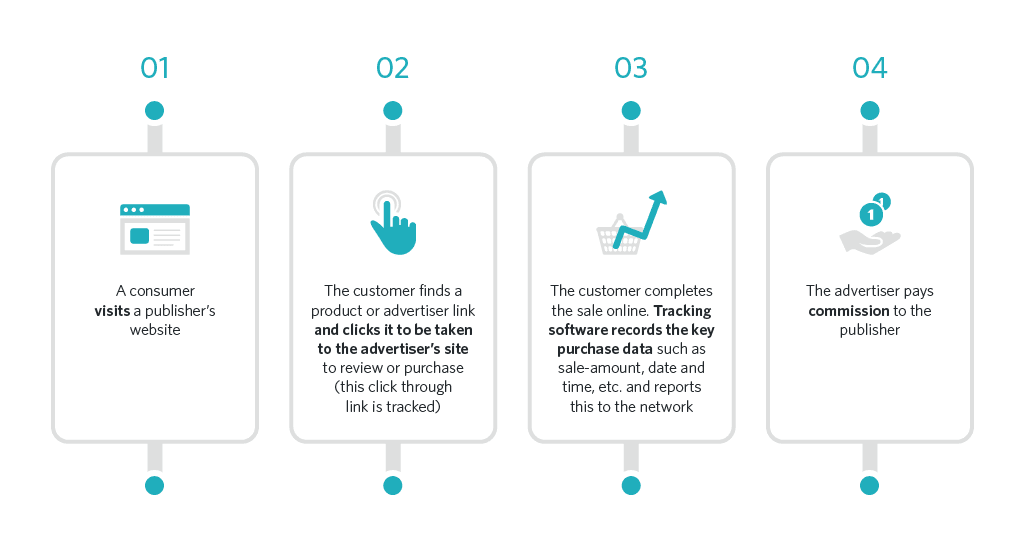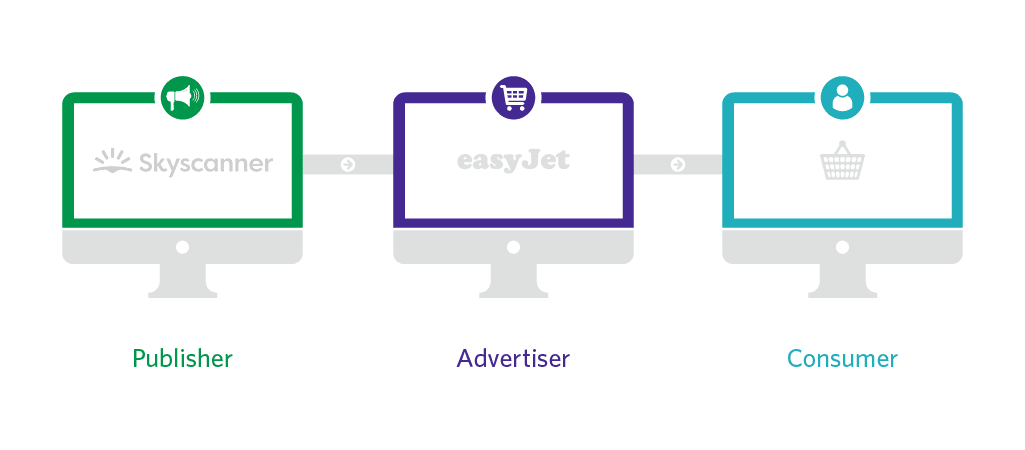What is affiliate marketing?
Written by Samantha Sherer on 8 minute read
If you’re looking to grow your business online, find out how affiliate marketing works with our simple introduction.

What is affiliate marketing?
Maybe you've heard the term, but still ask yourself, "What exactly is affiliate marketing?"
Affiliate marketing is a performance-based marketing channel in which a publisher is awarded a commission for sales they generate for an advertiser.
Publishers, also known as affiliates or partners, are the people that promote a product or service on their website for their readers.
Advertisers sometimes referred to as merchants or brands, is the term used for the person or company that has the product or service to sell. The third party in the affiliate marketing triangle is the consumer, who purchases an advertiser’s product or service via being directed there from a publisher’s website.
Publishers are rewarded commission when a visitor on their site clicks an affiliate link (for example a banner, logo or text link), goes to a particular advertiser's website and performs a certain action on the advertiser's site. Usually, this is completing a transaction. However, some advertisers ask publishers to refer traffic to them that results in a lead instead of a sale, perhaps through the completion of an online application form or the submission of the user's email address.

For example, when looking to purchase a new printer you may research offers on a website, such as RetailMeNot. Once you have found the best deal, in this case, HP printers, you would then click through the deal to their site to make a purchase. In this example, RetailMeNot is the publisher and the advertiser is HP, as this is the site where you complete the purchase. HP would then pay RetailMeNot a commission for generating a sale through their site.

What is an affiliate network?
An affiliate network, like Awin, controls tracking, payments and facilitates the relationships between publisher and advertiser.
Once signed up to Awin, publishers have the freedom to browse an array of different advertiser programs via our User Interface (UI) or Advertiser Directory and can request to join them. Once a publisher’s request to join an advertiser program has been accepted, they can begin promoting the advertiser products and services on their website and earn commission on sales they generate.
The UI dashboard hosts different tools to enable the tracking of the customer journey, and a range of reports so publishers can keep up to date with performance data. We also have a publisher management team to assist new and existing publishers throughout their affiliate marketing journey and a publisher training portal on our website to use as a resource.
How does our affiliate tracking work?
In order to track which publisher is generating sales for an advertiser and pay commission accurately, it’s essential to have a tracking program in place. Our tracking consists of five different elements:
- The MasterTag
- The Conversion Tag,
- Server-to-Server tracking
- Fall-back Conversion Pixel
- Product-Level Tracking
The MasterTag contains all the necessary functions for tracking, including creating a first-party cookie (which isn’t blocked by browsers), allowing for cross-device tracking and bypassing ad-blocking technologies. This JavaScript code allows for seamless tracking and needs to be integrated on every page of both the publisher’s and advertiser’s site, except those processing payment information.
The second element, the Conversion Tag, lets the MasterTag know a conversion has happened and it sits on the advertiser’s confirmation page. The MasterTag then sends the transactional information back to Awin for reporting and processing.
In the event the Conversion Tag does not work, a Fall-back Pixel is used as an additional tracking method that sits on the advertiser’s confirmation page and works similarly with the MasterTag.
Recently, browsers are blocking third-party cookies to protect consumer privacy in the wake of stricter data regulations. In order to guarantee the highest quality of tracking independent of browsers, Awin encourages all advertisers to implement Server-to-server tracking. This means tracking codes are activated from the server-side and sit on the advertiser’s confirmation page.
Product-Level Tracking is not mandatory but has many reporting benefits as it allows advertisers to track sales to each individually-purchased product. This means the performance of individual products and product categories can be easily measured. Once the MasterTag is properly set up, turning this element of tracking on is simple.
What is an affiliate publisher?
An affiliate publisher is an individual, company or business that earns commission from links promoting the advertisers’ products or services. These may be through the copy on websites, blogs or articles, social media posts, newsletter and email updates, or clickable banners or images.
An affiliate publisher works with advertisers either directly, through an agency or through an affiliate network. They sign up for advertisers’ affiliate programs matching their market and their audience’s needs. Any sales generated through their links are tracked so earnings can be accurately accredited to them.
If the publisher is working through a network, they have access to a variety of tools for reporting and support to help them monitor their promotional campaigns. To maximize the earning potential of a publisher’s audience, they will need to research the best affiliate programs available to do this.
How do I earn money?
Generally, affiliate programs work on a cost per acquisition (CPA) basis where the last publisher site visited before the consumer makes the sale is awarded a commission. For Awin, this means our publishers earn a commission based on a percentage of the final basket value from the sale they drove. While this is the most common form of payment, some publishers receive a commission for generating leads, clicks or impressions.
Cost per lead refers to the advertiser paying the publisher for any sign-ups they generate from interested customers. Payment on clicks will be each time an ad is clicked, whereas impression refers to the number of times an advertiser’s ad loads on the publisher page. Another payment type that Awin has implemented is ‘Commission by Assist.' This means that a publisher could be awarded a commission for a sale they have helped to generate, even if they weren’t the last click in the customer journey.
For example, if a consumer clicks on an affiliate link within an article of a blog, but before completing the purchase, searches and clicks through to a discount code site; traditionally, the coupon code publisher would be awarded for this sale, since they were the ‘last click.’ However, the affiliate marketing industry is becoming increasingly aware of the value that these upper-funnel publishers add to the consumer journey and are able to still reward them for their influence. Find out more here.
Any commissions publishers earn are displayed in your Awin account. Payments are released by Awin twice monthly (1st and 15th of each month) and sent directly to your specified bank account. For further information on the payment process, please click here.
What’s the difference between an advertiser and a publisher?
In a nutshell, an advertiser owns the product and the publisher promotes it. Advertisers are sometimes known as the merchant or the retailer, and they pay the publisher a commission for every sale that the publisher generates through their unique tracking code or ‘deeplink.’
The publisher advertises the product on behalf of the advertiser through different promotional methods, using a unique tracking link. The publisher’s aim is to drive as much traffic to the advertiser’s site or product page in the hope that a majority of consumers will buy; the more consumers they drive to make a purchase, the more commission they will earn.
The advertiser is responsible for the landing or product page that the publisher sends the traffic to, and everything that occurs from that point on, including fulfilling orders, refunds and returns.
What kind of publisher am I?
Publishers are categorized by the way in which a consumer would interact with their site. Some of the most well-known publisher types are:
Cashback: These sites reward customers through monetary rebates. Examples of a cashback publisher would be Ebates and Join Piggy.
Social & blogs: These are publishers that use social networks, such as Instagram or Facebook, to promote products as well as publishers who own their own site and write their own content through a blog.
Editorial content: This category is used for media houses, online newspapers, magazines and other wide-scale publications. Examples would be Forbes and BuzzFeed.
Discount Codes: This includes publishers who promote money off discounts using a coupon code such as Groupon and RetailMeNot.
For a more comprehensive list of different publisher types, please click here. If you would like to get started as a publisher, click here.
What if I’m an advertiser?
Awin works with over 25,000 advertisers globally across a variety of different sectors such as travel, retail, finance, telco and many more. If you are interested in beginning your affiliate marketing journey and creating relationships with a 270,000 database of active publishers please get in touch.




